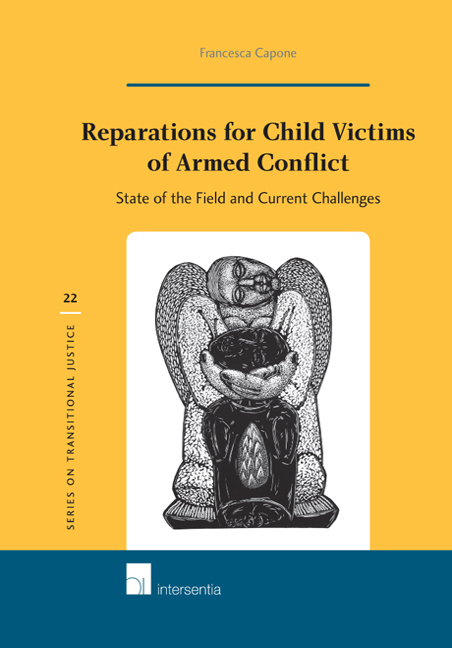Book contents
- Frontmatter
- Dedication
- Foreword
- About the Author
- Acknowledgements
- Contents
- Table of Cases
- Table of International Instruments
- List of Abbreviations
- Chapter 1 Setting the Scene
- PART I THE NORMATIVE AND THEORETICAL FRAMEWORK
- PART II CURRENT APPLICATION OF THE PRINCIPLES AND NORMS
- Chapter 5 Child Victims’ Right to Reparation in ‘Quasi-Judicial’ and Judicial International Settings
- Chapter 6 Child Victims’ Right to Reparation in ‘Quasi-Judicial’ and Judicial Regional Settings
- Chapter 7 Child Victims’ Right to Reparation in Non-Judicial Settings
- Chapter 8 Final Remarks
- Bibliography
- Index
Chapter 5 - Child Victims’ Right to Reparation in ‘Quasi-Judicial’ and Judicial International Settings
from PART II - CURRENT APPLICATION OF THE PRINCIPLES AND NORMS
Published online by Cambridge University Press: 29 September 2018
- Frontmatter
- Dedication
- Foreword
- About the Author
- Acknowledgements
- Contents
- Table of Cases
- Table of International Instruments
- List of Abbreviations
- Chapter 1 Setting the Scene
- PART I THE NORMATIVE AND THEORETICAL FRAMEWORK
- PART II CURRENT APPLICATION OF THE PRINCIPLES AND NORMS
- Chapter 5 Child Victims’ Right to Reparation in ‘Quasi-Judicial’ and Judicial International Settings
- Chapter 6 Child Victims’ Right to Reparation in ‘Quasi-Judicial’ and Judicial Regional Settings
- Chapter 7 Child Victims’ Right to Reparation in Non-Judicial Settings
- Chapter 8 Final Remarks
- Bibliography
- Index
Summary
INTRODUCTION
The aim of this chapter is to analyse how child victims ‘right to reparation is exercised in international quasi-judicial and judicial settings. Since the focus of the present work is on child victims of armed conflict, this part will introduce and discuss only those bodies that have dealt (or are likely to deal in the future) wiThthe consequences of gross human rights violations and serious violations of humanitarian law perpetrated against children during or in the aft ermaThof NIACs and IACs. The actors responsible for satisfying children's right to reparation are traditionally national and international criminal courts dealing wiThindividual perpetrators, regional human rights bodies, States, TCs, trust funds and other transitional justice instruments. They can act in concert as components of a holistic justice process or they can behave independently when no such process of integral transition has been set up in the country.
The first part of the book served the purpose of laying down the theoretical framework that governs children's right to reparation, explaining inter alia which are the key developments under international law and their impact on child victims. The present part will deal wiThthe concrete issues arising when children ‘face’ the actors entitled to award reparations as the outcomes of judicial proceedings or as the results of national strategies. This chapter, in particular, will discuss to what degree international bodies, quasi-judicial and judicial, comply wiThthe demand to award reparations, which are adequate, prompt and effective.
COMPLAINT MECHANISMS OF UN TREATY BODIES AND THE THIRD OPTIONAL PROTOCOL TO THE CONVENTION ON THE RIGHTS OF THE CHILD ON A COMMUNICATIONS PROCEDURE
The UN has two different types of dedicated human rights mechanisms, namely those established under a human rights treaty and those set up under the Human Rights Council. The latter are often described as ‘Charter-based’ mechanisms, ‘non-conventional mechanisms’ or ‘non-treaty procedures’. The mechanisms established under the Human Rights Council may be divided into procedures at the level of the Council itself and the ‘special procedures’, which include also the Special Rapporteur on the promotion of truth, justice, reparation and guarantees of non-recurrence.
- Type
- Chapter
- Information
- Reparations for Child Victims of Armed ConflictState of the Field and Current Challenges, pp. 141 - 182Publisher: IntersentiaPrint publication year: 2017



